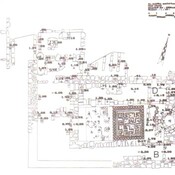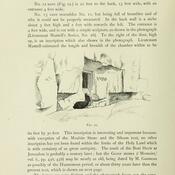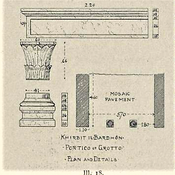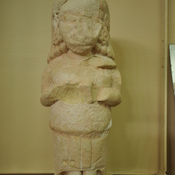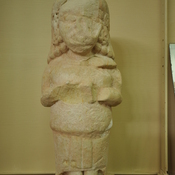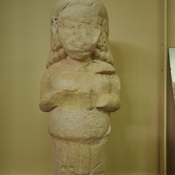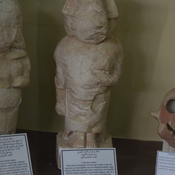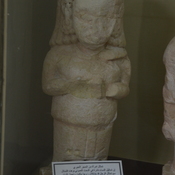Qasr al-Abd near modern town of Iraq al-Amir was founded by Hyrcanus in the second century BC. Hyrcanus was a member of a powerful Tobiads family known as philhellene, According to Rosenberg, Qasr al-Abd has many features of a monumental, Hellenistic-style mausoleum1. The ruins described by H.C. Butler in 1907 consisted of the building known as Qasr Al-Abd, two gatesways, building on the norther terrace, the terrace walls, an aqueduct, and the rock-hewn chambers.
Qasr al-Abd (Castle of the Slave) is believed to be Tyros, the palace of a Tobiad notable family.
The origin of the castle described Joseph Flavius in his Antiquities:
..upon the death of Joseph [ of the high priest's family ], the people grew seditious, on account of his sons. For whereas the elders made war against Hyrcanus, who was the youngest of Joseph's sons, the multitude was divided, but the greater part joined with the elders in this war; as did Simon the high priest, by reason he was of kin to them. However, Hyrcanus determined not to return to Jerusalem any more, but seated himself beyond Jordan, and was at perpetual war with the Arabians, and slew many of them, and took many of them captives. He also erected a strong castle, and built it entirely of white stone to the very roof, and had animals of a prodigious magnitude engraven upon it. He also drew round it a great and deep canal of water. He also made caves of many furlongs in length, by hollowing a rock that was over against him; and then he made large rooms in it, some for feasting, and some for sleeping and living in. He introduced also a vast quantity of waters which ran along it, and which were very delightful and ornamental in the court. But still he made the entrances at the mouth of the caves so narrow, that no more than one person could enter by them at once. And the reason why he built them after that manner was a good one; it was for his own preservation, lest he should be besieged by his brethren, and run the hazard of being caught by them. Moreover, he built courts of greater magnitude than ordinary, which he adorned with vastly large gardens. And when he had brought the place to this state, he named it Tyre. This place is between Arabia and Judea, beyond Jordan, not far from the country of Heshbon. And he ruled over those parts for seven years, even all the time that Seleucus was king of Syria. But when he was dead, his brother Antiochus, who was called Epiphanes, took the kingdom. Ptolemy also, the king of Egypt, died, who was besides called Epiphanes. He left two sons, and both young in age; the elder of which was called Philometer, and the youngest Physcon. As for Hyrcanus, when he saw that Antiochus had a great army, and feared lest he should be caught by him, and brought to punishment for what he had done to the Arabians, he ended his life, and slew himself with his own hand [in 176 BC]; while Antiochus seized upon all his substance.
The connection of the site with the Tobiads is based on a cave inscription found nearby. The castle was used during the Hellenistic and Roman periods also.
See:
- Piotr Bienkowski, Jordan: Crossroads of the Near East, in: Treasures from an Ancient Land: The Art of Jordan, ed. Piotr Bienkowski, Stroud, UK: Alan Sutton 1991, pp. 16-17
- Howard Crosby Butler, Syria: publications of the Princeton University Archaeological Expeditions to Syria in 1904 - 5 and 1909 (Div. 2, Sect. A ; 1): Ammonitis — 1907, p. 1-25
- Josephus Flavius, Antiquities of the Jews, translated by William Whiston, Book XII, Chapter IV, 11
- Claude Reignier Conder, The survey of eastern Palestine. Memoirs of the topography, orography, hydrography, archaeology, etc. v.1--The 'Adwân country (1889) pp. 66-87 - https://archive.org/details/surveyofeasternp00conduoft/page/65/mode/2up?view=theater&q=abd
- Stephen Rosenberg, “Castle of the Slave”—Mystery Solved,Biblical Archaeology Society 33, 2012
- http://www.biblicalarchaeology.org/daily/biblical-sites-places/biblical-archaeology-sites/was-qasr-al-abd-
- M. Waheeb, A. Mahmod, Discovery of Jesus Cave in Iraq Al-Amir, Southern Levant-Jordan,International Journal of Innovative Research and Knowledge, Volume-2 Issue-10, October-2017modeled-after-the-mausoleum-at-halicarnassus/
- http://www.kinghussein.gov.jo/tourism2.html
















